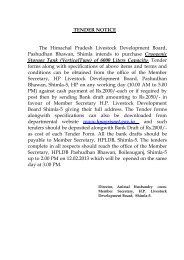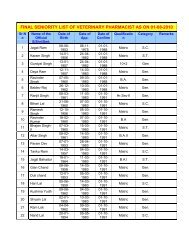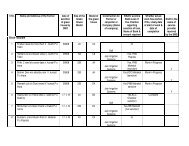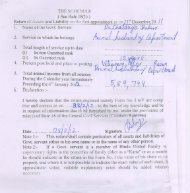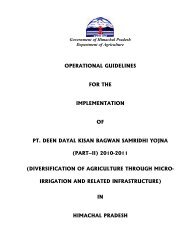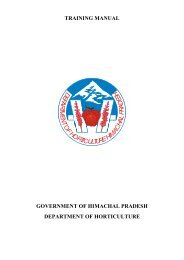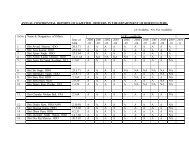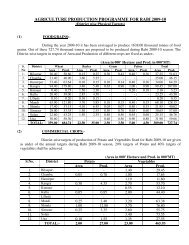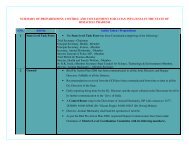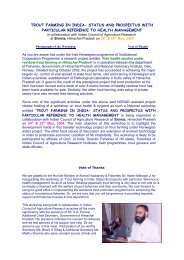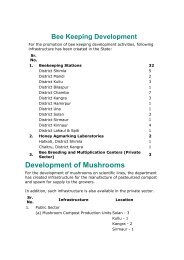Centrally Sponsered Schemes
Centrally Sponsered Schemes
Centrally Sponsered Schemes
Create successful ePaper yourself
Turn your PDF publications into a flip-book with our unique Google optimized e-Paper software.
Insurance Co. of India (AICI) is implementing the scheme. The farmers of the State can getbenefit out of this programme. State and Government of India share the losses equally. FromRabi, 2007-08, the subsidy on premium has been raised from 10% to 50% to small & marginalfarmers. Ginger crop of District Sirmour has been included in this scheme on pilot basis fromKharif, 2008.a) Objectives:1. To provide insurance coverage and financial support to the farmers in the event offailure of any of the notified crop as a result of natural calamities, pests & diseases.2. To encourage the farmers to adopt progressive farming practices, high value in-puts andhigher technology in Agriculture.3. To help stabilise farm incomes, particularly in disaster years.b) Farmers to be covered:The Scheme covers following groups of farmers:On a compulsory basis: All farmers growing notified crops and availing SeasonalAgricultural Operations (SAO) loans from Financial Institutions i.e. Loanee Farmers.On a voluntary basis: All other farmers growing notified crops (i.e., Non-Loanee farmers) whoopt for the Scheme.c) Risks Covered:Comprehensive risk insurance will be provided to cover yield losses due to non-preventablerisks, viz.:1. Natural Fire and Lightning2. Storm, Hailstorm, Cyclone, Typhoon, Tempest, Hurricane, Tornado etc.3. Flood, Inundation and Landslide4. Drought, Dry spells5. Pests/ Diseases etc.d) Seasonality Discipline:The broad seasonality discipline followed for Loanee farmers willbe as under:Activity Kharif RabiLoaning period April to September October to Next MarchCut-off date for receipt of declarations November MayCut-off date for receipt of yield data January / March July / SeptemberThe broad cut-off dates for receipt of proposals in respect of Non-loaneefarmers will be as under :Kharif season : 31st JulyRabi season : 31st DecemberHowever, seasonality discipline may be modified, if and where necessary inconsultation with State / UT and the Govt. of India.B). Pilot Weather based crop insurance scheme (WBCIS):In addition to this, from Rabi, 2008-09 season, tomato crop of District Solan hasbeen covered under weather based crop insurance scheme for the first time. From the Rabi2009-10 season, Rabi potato crop has also been covered under weather based crop insurancescheme in the Districts of Kangra and Una.
a) Objectives:1. To provide insurance coverage and financial support to the farmers in the event offailure of any of the notified crop as a result of natural calamities, pests & diseases.2. To encourage the farmers to adopt progressive farming practices, high value in-puts andhigher technology in Agriculture.3. To help stabilise farm incomes, particularly in disaster years.b) Perils Covered:Following weather perils, which are deemed to cause” Adverse weatherincidence”, leading to crop losses, would be covered under the scheme;Temperature(Low temperature(frost), Chilling, High mean temperature, temperaturefluctuation), Wind speed and Rainfall( deficit/excess).c) Seasonality Discipline:The broad cut-off dates for receipt of proposals in respect of Loanee & Nonloaneefarmers will be as under :Kharif season : AugustRabi season : March-April9. KISAN CALL CENTRE:Under this, farmers can get any information on agriculture by dialling toll freenumber 1800-180-1551 or 1551. The service is available from 6.00 AM to 10.00 PM on all days.This is 100% <strong>Centrally</strong> Sponsored Scheme.10. RASHTRIYA KRISHI VIKAS YOJNA ( RKVY ) (100%CSS) :Concerned by the slow growth in Agriculture and allied sectors, the Governmentof India has launched a special Additional Central Assistance Scheme Rashtriya Krishi VikasYojna (RKVY). The RKVY aims at achieving 4% annual growth in the agriculture sector during theXI Plan period, by ensuring a holistic development of Agriculture and allied sectors. The schemeis being implemented in the State of Himachal Pradesh from the year 2007-08 to achieveenvisaged annual growth rate. This scheme has also been continued by the Govt. of Indiaduring 12 th Plan.a). Objectives of the scheme:I. To incentives the states as so as to increase public investment in Agriculture and alliedsectors,II. To provides flexibility and autonomy to states in the process of planning and executingAgriculture and allied sector schemes,III. To ensure the preparation of agriculture plans for the districts and the states based onagro-climatic conditions, availability of technology and natural resources,IV. To ensure that the local needs/ crops/ priorities are better reflected in the agriculturalplans of the states,V. To achieve the goal of reducing the yield gaps in important crops, through focusedinterventions,VI. To maximize returns to the farmers in Agriculture and allied sectors,
VII. To bring about quantifiable changes in the production and productivity of variouscomponents in Agriculture and allied sectors by addressing them in a holistic manner.b). Area of Focus under RKVY:I. Integrated development of major food crops such as wheat, paddy, coarse cereals,minor millets, pulses & oilseeds.II. Activities related to enhancement of soil health and mechanization.III. Development of rain fed farming systems in and outside watershed areas.IV. Support to state seed farms and IPM.V. Strengthening of market infrastructure and marketing development.VI. Strengthening of infrastructure to promote extension services.VII. Activities relating to enhancement of horticultural production and popularization ofmicro irrigation systems.VIII. Animal husbandry and fisheries development activities.IX. Organic and bio-fertilizers and innovative schemes.Government of India has allocated funds to the tune of Rs 73.48 crores during2012-13 for Agriculture growth, which includes Horticulture, Animal Husbandry, Fisheries andR&D, the detail of which is as under:(Rs. in lakh)S.No. Name of Scheme Allocation for 2012-131 Normal RKVY 4506.002 National Mission on Protein Supplements (NMPS)Dairy - 624.00Goatery - 100.00(c) Fisheries - 918.001642.003 National Vegetable Initiative for Urban Clusters 1200.00Total:- 7348.00Keeping in view the allocation received from the Govt. of India, the meetings ofState Level Sanctioning Committee and State Level Committee has already been convened toapprove the projects under Stream-I & Stream-II. On the basis of projects approved, theallocation of funds had also been made amongst different stakeholder departments as perdetail given below:(Rs. in lakh)S.No. Name of the Department Funds allotted1. Agriculture 3733.502. Horticulture 504.503. Animal Husbandry 1884.004. Fisheries 1126.005. Industries 100.00Total:- 7348.0011. RURAL INFRASTRUCTURE DEVELOPMENT FUND (R.I.D.F.):
The Department of Agriculture is participating in RIDF for creation of irrigationpotential through minor irrigation/ WHS. The Department got funds under RIDF-V during 1999-2000 where NABARD sanctioned 157 FIS amounting to Rs.14.85 crores which has createdirrigation potential of 3,560 hect. These schemes are being executed through Water UsersAssociations who will also maintain them after their completion. Under RIDF-VI, 140 flowirrigation schemes were posed to NABARD which have been sanctioned for Rs.11.37 crorescovering an area of 3,031 hect. Under RIDF-VII, 126 schemes worth Rs.7.84 crores have beensanctioned, which will create CCA of 2,395 hectare. Besides, 90 water harvesting projects havebeen sanctioned for Hamirpur, under RIDF-VII with cost of Rs.6.78 crores. Under RIDF-IX, 200minor irrigation schemes amounting to Rs.8.32 crores have been executed creating CCA 7,161hectares. Under RIDF XII, 150 minor irrigation schemes amounting to Rs. 9.01 crores have beenexecuted creating CCA 1333.62 hectares during 2006-07. During the year 2007-08, an amountof Rs. 9.57 crores has been incurred creating CCA 1418.00 hectare. At the end of the financialyear 2008-09, an amount of Rs. 10.50 crores has been incurred for creating CCA 1300 hectare.From 2009-10 onward, the Planning Department has stopping funding for soil & waterconservation, irrigation to Agriculture Department under RIDF.12. PROJECT UNDER RURAL INFRASTRUCTURE DEVELOPMENT FUND-XIV ( RIDF-XIV ) :For inclusive growth in agriculture and to provide gainful employment to oursmall and marginal farmers at their farms, the scheme has been implemented during the year,2008-09 with a total outlay of Rs. 353 crores. Under this scheme, the farmers were encouragedto install polyhouses for production of vegetables and assistance to the tune of 80% of the costfor G.I. poly house and 90% for bamboo poly house is being provided through the Departmentof Agriculture, H.P. Polyhouses of the size of 40, 100, 250, 500 and 1000 sqm. are beingconstructed.The poly house of 250 sqm. provides employment to 2-3 persons round the year.Besides this, for efficient use of irrigation water, micro irrigation systems are also beinginstalled within polyhouses and outside the polyhouses, on which 80% capital subsidy. Forcreation of water sources like tanks, wells, small lifts, 50% assistance is being provided underthe scheme. For polyhouses & other related water sources, Rs.154 crore was sanctionedwhereas for bringing 20,000 ha. area under micro-irrigation Rs.198 crore was sanctioned.A. PRODUCTION OF CASH CROPS BY ADOPTION OF PRECISION FARMING PRACTICESTHROUGH POLY HOUSE CULTIVATION.The objectives of the project are higher productivity and income per unit area,judicious use of natural resources like land and water, year round availability of vegetables,assured production of quality produce and increased efficiency of monitory inputs. NABARD hassanctioned this project under RIDF XIV amounting to Rs. 154.92 crores that shall beimplemented in 4 years starting from the financial year 2008-09.The Project components include construction of polyhouses providing microirrigationin the polyhouses through sprinkler and drip. For both these components, the farmerswould be provided 80% subsidy and 20% would be beneficiary’s contribution. Besides this, thefarmers shall be provided with 50% assistance for creation of water resources for these poly
houses like farm tanks, shallow wells, pumping sets, small lifts etc. In all 28820 poly house /micro- irrigation system will be constructed during the project period covering an area of 147hectares. 90% subsidy is being provided to small and marginal farmers and to BPL families forthe construction of bamboo polyhouse. Depending upon the area and site, different models ofpoly houses ranging from low cost tunnel, low cost poly houses made of local material, mediumcost poly houses made of local material and medium cost poly houses with standard materialshall be constructed. Besides this, 2650 no. of water sources like tanks, shallow wells, pumpingsets shall also be constructed on the basis of actual need. Up to 2011-12, 10105 Polyhouseshave been constructed. An area of 111.25 Ha. have been covered under protected cultivationand expenditure of Rs. 82.76 Crore has been incurred. A budget provision of Rs.35.0 Crore hasbeen made for 2012-13.B. SPECIAL PROJECT ON DIVERSIFICATION OF AGRICULTURE THROUGH MICROIRRIGATION AND OTHER RELATED INFRASTRUCTURE IN HPAlthough water is a renewable resource, its availability in appropriate quality andquantity in under severe stress due to increasing demand from various sectors. Agriculture isthe largest user of water, which consumes more than 80% of the country’s exploitable waterresources. The over all development of agriculture sector and indented growth rate of GDP islargely dependent on the judicious use of available water resources, while the irrigationprojects [major and medium] have contributed to the development of water resources, theconventional methods of water conveyance and irrigation, being highly inefficient, has led notonly to wastage of water but also to several ecological problems like water logging, salinisationand soil degradation making productive agricultural lands unproductive. It has been recognisedthat use of modern irrigation methods like drip and sprinkler irrigation is the only alternativefor efficient use of surface as well as ground water resources. Hence, this project ondiversification through micro irrigation and other related infrastructure in HP aims at increasingthe area under efficient methods of irrigation viz., drip and sprinkler irrigation. NABARD hassanctioned this project under RIDF- XIV amounting to Rs.198.09 crores starting from 2009-10.The project components include sprinkler system, drip system, farm tank, shallow well, shallowtube well, deep tube well, small and medium lifts and pumping machinery. In all 17,312sprinkler / drip irrigation systems shall be installed during the project period. Besides this,16020 nos. of water resources like tanks, shallow well, shallow tube well, deep tube well, smalland medium lifts and pumping machinery shall also be constructed on the basis of actual need.For sprinkler and drip systems, the farmers shall be provided 80% subsidy and 20% would bebeneficiary’s contribution. Besides this the farmers shall also be provided 50% assistance forcreation of farm tank, shallow well, shallow tube well, deep tube well, small and medium liftsand pumping machinery. A farmer can install sprinkler system up to 4 hectares of land whereasfor drip up to one hectare. Up to 2011-12, 16795 sprinkler sets have been installed covering anarea of 11458.12 Ha. and sum of Rs. 5924.92 has been spent. A budget provision of Rs.15.44Crore has been made for this component during 2012-13.13. NATIONAL FOOD SECURITY MISSION ( NFSM ) :
The National Food Security Mission is a centrally sponsored scheme hasbeen launched in 2007. Government of India has allocated funds to the tune of Rs 22 croresduring 2012-13 for rice and wheat crop. Himachal Pradesh has been included under thisMission to increase the production and productivity of Wheat and Rice. Under this Mission, 10Districts in Wheat and three Districts under Rice have been selected in the State. The Missionprovides assistance for laying cluster demonstrations, distribution of Certified Seed, Micro-Nutrients, Plant and soil protection material, liming of acidic soils, improved implements andmachinery, introduction of IPM, INM and capacity building of the farmers. Besides thisassistance would be available for water harvesting, Micro irrigation & pumping sets. A sum of. 4.95 crore have been approved for NFSM Rice and . 17.05 crore for NFSM Wheat for theyear 2012-13.The Department has already started implementation of NFSM Rice during currentKharif season. The Mission would be very helpful in increasing the productivity level of Rice andWheat. For smooth implementation of the Mission in the Districts the District level NFSMExecutive Committees have also been constituted in all the districts.Objectives of this scheme:a. Increasing production of rice and pulses through area expansion and productivityenhancement in a sustainable manner in a identified district of the State.b. Restoring soil fertility and productivity at the individual farm level.c. Creation of employment opportunities.d. Enhancing farm level economy i.e. farm profits to restore the confidence among thefarmers.14. ORGANIC FARMINGOrganic agriculture is a holistic production management system whichpromotes and enhances agro-ecosystem health, including biodiversity, biological cycles, andsoil biological activity. Its emphasis is on the use of management practices in preference to theuse of off-farm inputs, taking into account that regional conditions require locally adaptedsystems. This is accomplished by using, where possible, cultural, biological and mechanicalmethods, as opposed to using synthetic material, to fulfill any specific function within thesystem. The State of Himachal Pradesh has started taking steady strides towards thepromotion of organic farming. There is an increasing awareness about organic agriculturepractices in the state. Besides, most of the remote and inaccessible areas are still continuingwith the traditional methods of crop production using organic manures as the only source ofthe nutrients.It includes all the agricultural production systems that promoteenvironmentally, socially and economically sound production of food and fibers. In this systemsoil fertility is the key to successful production. Organic farming aims to optimize quality in allaspects of agriculture by taking into consideration the natural capacity of plants, animals andthe land. It emphasizes on the health of agricultural ecosystem and prohibits the use ofsynthetic herbicides and pesticides, genetically modified organisms, synthetic fertilizers in cropproduction and hormones and antibiotics in livestock production. It respects the law of natureto increase yields and disease resistance. Organic farming requires a high level of farm
management skills and require use of vide variety of resources to solve the problems. Theorganic farming focuses on;Maximize biological activity in soilsMaintain long term soil health and minimize soil erosionEnhance the genetic and biological system and its surroundingsProvide livestock with optimal living conditions for well being and better healthRecycling of materials of plant and animal origins, nutrients to the land (soil andminimize the use of non renewable resourcesPromotion of environmentally friendly use of soil, water and air thus minimizingagricultural pollutionFertility management in different types of soils is very crucial and criticalto increase the productivity under organic farming. Fertility management encompassesapplication and addition of nutrients supplying materials, which include chemical fertilizers,organic manures and other ameliorants. Efficacy of added materials depends on several factorslike structure of soil, drainage and tilth etc. It has been found that continuous use of chemicalfertilizers has lead to several problems in hill soils i.e. reduction in pH, deficiency of secondaryand micro nutrients and reduced biological activity. It is tradition in hills to add organic manuresin the soils which also supplement nutrition and also improves physical and biologicalproperties of soils. Practice of incorporation of organic manure is very good, but farmers usuallyadd partially decomposed biomass, which account for immobilization of available nutrients insoil particularly Nitrogen and also it is the chief source of insects attack, fungal and weedinfestation.The most challenging time in the organic farming system is the transition phaseas the farmer switch from conventional to organic agriculture. During the early stages ofconversion, drop in yields up to 30 % have been reported by farmers who were dependent onherbicides, fertilizers and pesticides and it takes about decade for their yields to recover. Butsome farmers observed that the yields rebound within just a few years as they were using onlyminimum inputs. The yields tend to increase with the number of years under organicmanagement as farmers gain experience and soil improves. It has also been reported thatorganic farms have higher yields than conventional farms under stress caused by drought, heat,excessive rainfall or unreasonably cold weather.Organic farming tends to have lower cost of production than conventionalfarming, as less emphasis on purchased inputs. Similarly, the net income from organic farmingappears to be slightly higher than the conventional farming. In general, the expenses are lowerand the income is higher (due to price premium).Keeping in view importance and scope of Organic Farming, the Governmenthas already notified the policy for its adoption and fulfillment of need based organic farmingpolicy objectives. The present project proposal is prepared in consideration of the organicfarming policy document of Himachal Pradesh giving thrust to some of the strategies to beadopted viz, Govt. support to organic sector, support to organic farmers, the incentiveschemes for the farmers and strategy for awareness raising. The main features of organicpolicy are as under:
1. Incorporation of organic into agriculture development.2. Awareness raising.3. Research and Technology support.4. Strengthening Organic Extension services support.5. Organic quality assurance.6. Meeting organic input requirement.7. Supply chain and marketing.8. Identifying Niche Areas for organic farming and converting institutional farms etc.Justification/Objectives:To promote the policy relating to adoption of Organic FarmingPromotion of environment friendly agricultureRecycling & use of farm waste biomass, thereby reducing the cost of productionTo improve the physical and biological properties of soils, shelf life and flavour of farmproduceTo reduce the use of inorganic fertilizersTo increase export of farm produceImprovement of soil healthONGOING PROGRAMMES:-1. A turn-key organic cluster project in 1200 Ha in HPProject costRs. 267 lacDurationThree yearsProject areaBilaspur, Solan and HamirpurProject partners -Department of Agriculture, HP-CSK HPKV, Palampur- International Competence Centre for Organic Agriculture,BangaloreProject components Area to be covered under organic farming- 1200 HaNo. of farmers to be covered under organic certification- 2600No. of Vermicompost unit to be set up- 800Market linkage, contract farming through farmer groups andmarketing agenciesStrategy paper and Package of practices2. Project on Organic FarmingProject costRs. 278.34 lacDurationTwo yearsProject areaKullu, Mandi, Kangra and ShimlaProject partners -Department of Agriculture, HP-CSK HPKV, Palampur
Project components- Himachal Organic Farmers’ Forum (HOFF)Area to be covered under certified organic farming- 1300 Ha.Marketing management of organic produce3.Rashtriya Krishi Vikas Yojana- Promotion of organic farmingAssistance for organic certification through cluster approachfor 3yearsAssistance for construction of vermicompost units/HDPEPortable UnitAssistance for Area Expansion under organic farming@ Rs.10,000/- per hectare@ Rs.4000 per unit@ Rs.10000/-per hectareACHIEVEMENT OF ORGANIC FARMING IN THE STATE:Sr. Particulars Unit Achievementno.1 Farmers registered under organic farmingCertifiedUnder conversionNos.Nos.Nos.25,160367821,4822 Area under organic farming Ha 12,5003 Vermiculture hatcheries Nos. 204 Vermicompost unit Nos. 4,14,2305 Bio-fertilizer production unit Nos. 46 Bio-control Labs Nos. 47 Fair Nos. 28 Distribution of literature1) Adhunik Kheti Me Jaiv Urvarkon (Bio- fertilizers)Ka Mahtav Aur istemal2) Jaivik Krishi Ke Rashtriya Manak3) Kenchua Khad–Bhoomi Ke Upjaupan Ke LiyeVardan4) Kenchua Khad5) Jaivik Kheti6) Organic farming7) Potash mobilising bacteria8) Bio- treated seeds9) NPK-liquid bio-fertilizers10) Bio-control agents and bio-pesticides11) Jaivik Kheti12) Jaivik Kheti Neeti13) HP Organic Policy Hindi/EnglishNos.Nos.Nos.Nos.Nos.Nos.Nos.Nos.Nos.Nos.Nos.Nos.Nos.15,00050,00050,00020,00020,0006,000439600336502100010001000
15. AGRISNET PROJECT:The Government of India has launched a Central sector scheme titled“Strengthening of/ promoting agricultural informatics and communications“ of which onecomponent is AGRISNET [Agricultural Resources Information System network] .This envisagesthat the tools of ICT would provide networking of agriculture sector not only in the country butglobally and the state government department will have reservoir of database. It will bringfarmers, researchers, scientists and administrators together by establishing Agricultureinformation online. AGRISNET proposes to create an interactive interface for Government toCitizen (G2C) i.e. for Farmers and Government to Government (G2G) services i.e. services forthe Department of Agriculture, Horticulture, Animal Husbandry and Fisheries. The proposedsystem would maintain a database of information about various activities of the respectiveDepartments. This database would be used to provide information and services to the users.The following Government to Citizen (G2C) and Government to Government (G2G) Serviceswould be provided by using ICT tools:-Government to Citizen (G2C): Information dissemination and FAQs, Curbing diseases andmaintaining general health, Supply of different items, Trainings and services, Expert advisoryservices, Market information, Application formsGovernment to Government (G2G) Services: Generation of database of respectiveDepartments, to exchange and disseminate informationGovt. of India has approved Rs. 703.12 Lakh as the total cost of project.Government of India has released Rs 132.60 Lacs on 24/7/06 and Rs. 570.52 Lacs on 18/2/09.The hardware has been procured and installed in all stakeholder Departments. Softwarerequirement specifications [SRS] have been prepared and software development work has beenawarded to M/s Samtech Infonet Ltd.AGRISNET Portal has been launched officially on 28/7/10 and is available athttp://hpagrisnet.gov.in. Department of IT, HP has developed a data structure in the form ofAGRISNET Portal, which encompasses wide array of information on district wise package ofpractices of major crops, Agriculture, Horticulture, Animal husbandry and Fisheries, collectedfrom different stakeholder Departments. Such data Bank will facilitate Stakeholderdepartments to provide correct answers to the farmers and may also be used by extensionpersonnel and farmers directly to download application / subsidy forms.16. National e-Governance Plan –Agriculture [NeGP-A]:Government of India has started a centrally sponsored scheme *CSS+ “Nationale-Governance Plan –Agriculture [NeGP-A] in Department of Agriculture and Co-operation withoutlay of Rs. 227.79 Crores. Government of India has approved an outlay of Rs. 12 Crores forthis scheme during year 2010-11. In first phase, the scheme is being implemented in 7 statesincluding HP. Department of It, has been appointed nodal agency for the implementation of[NeGP-A] in HP and funds to the tune of Rs. 1 Crore has been released directly to “Society forpromotion of IT & e-governance (SITEG), HP” an autonomous body on dated 31/3/2011.
The vision behind the project is to create an environment conducive for raisingfarm productivity and income to global levels through provision of relevant information andservices to stakeholders. Various IT initiatives/ schemes undertaken or implemented by DACwhich are aimed at providing information to the farmers on various activities in agriculturevalue chain, will be integrated, so that farmers are able to make proper and timely use ofavailable information. The information is intended to be provided to farmers through variouschannels including common service centres, internet kiosks and SMSs. 12 clusters of serviceshave been identified.Sr. Name of servicesNo.1 Information on Pesticides, Fertilisers and Seeds2 Providing Information on Soil health3 Information on Crops, farm machinery, Training and Good Agricultural practices(GAPs)4 Information on Forecasted Weather5 Information prices, arrivals, procurement points and providing interaction platform6 Electronic Certification for Exports and Imports7 Information on marketing infrastructure8 Monitoring implementation / Evaluation of <strong>Schemes</strong> & programs9 Information on Fishery Inputs10 Information on irrigation infrastructure11 Drought Relief and Management12 Livestock ManagementState Government has constituted one State Empowered Committee and 12District NeGP-A Implementation Teams for the implementation of this plan and fixed the rolesand responsibilities of committees.17. Aryabhatta Geo-informatics & Space Application Centre (AGiSAC)The State Council for Science, Technology and Environment H.P. has establishedAryabhatta Geo-informatics & Space Application Centre (AGiSAC) which would function asnodal agency to facilitate the use of spatial and Geo-spatial technologies for the planning anddevelopmental activities in the State.Objectives:1. To facilitate decentralized planning and decision making.2. To facilitate Monitoring and Evaluation of Government <strong>Schemes</strong> & Programmes.3. To set up integrated natural resources data management system.4. To provide services/consultancy based on specific user needs in the field of RemoteSensing and GIS.5. To provide wider usage of geo-spatial applications through simultaneous supportsystems/ software.
6. To promote the use of SATCOM networks for distant interactive training andeducation in the State.Services for Agriculture Department:-1. Agriculture Information System{Administrative structure, Agriculture infrastructure (Polyhouse, Micro-IrrigationUnits & Biogas Units) & Databases}1. Agro - Advisory(Soil trearment)2. Decision support system (Vermicompost units)The centre has developed online SMS based recommendations for farmersregarding Soil Health status initially for Bilaspur District.



